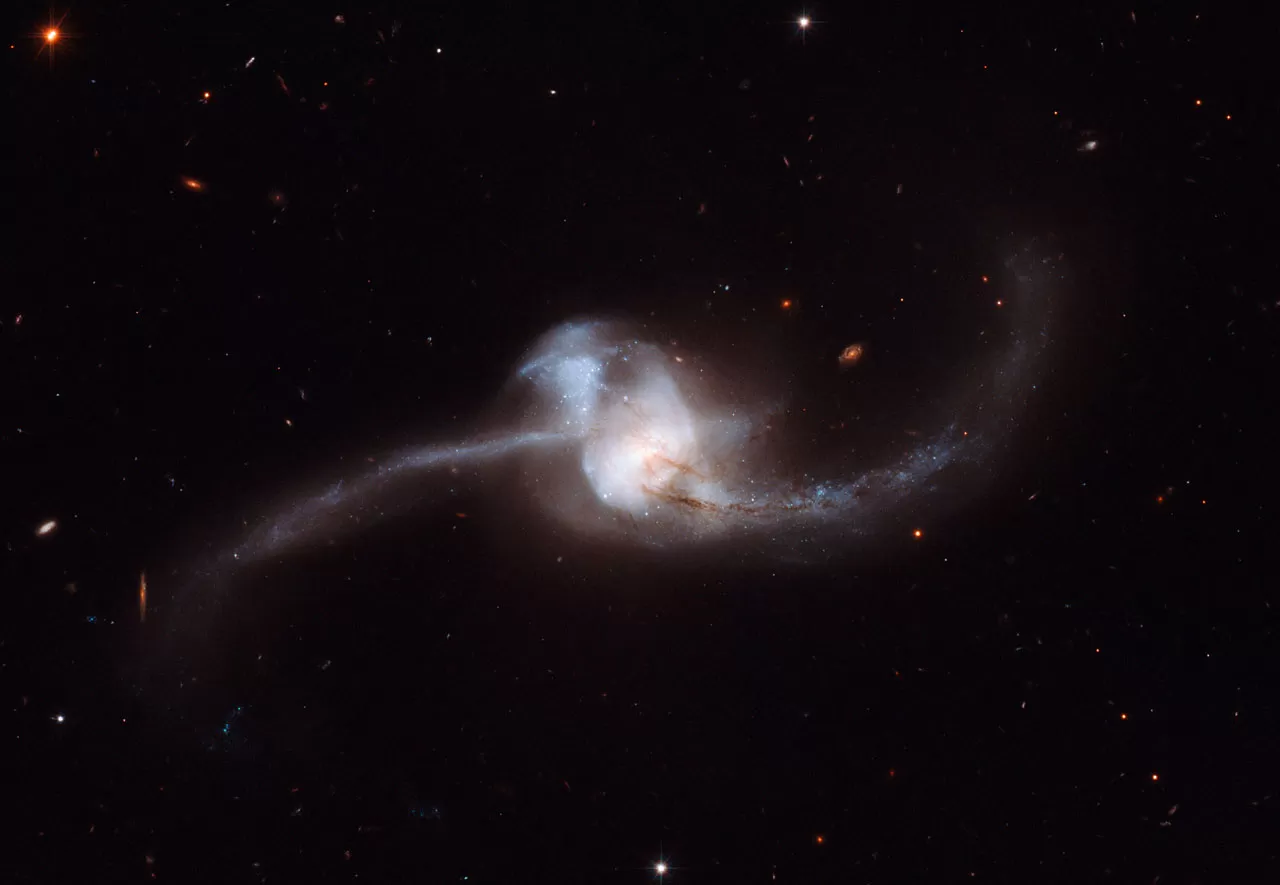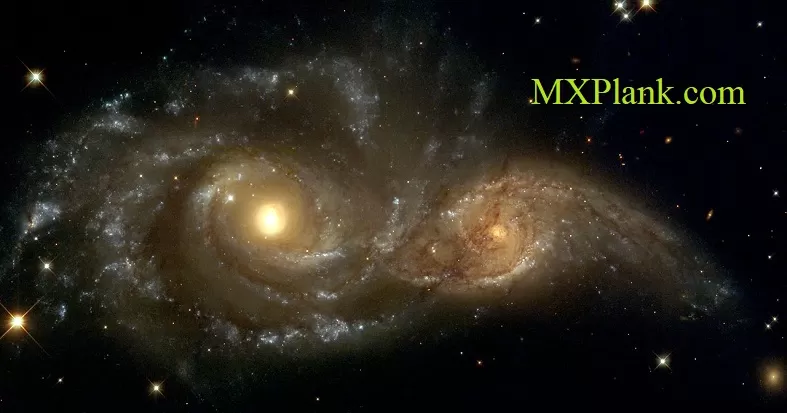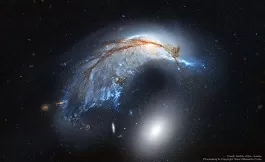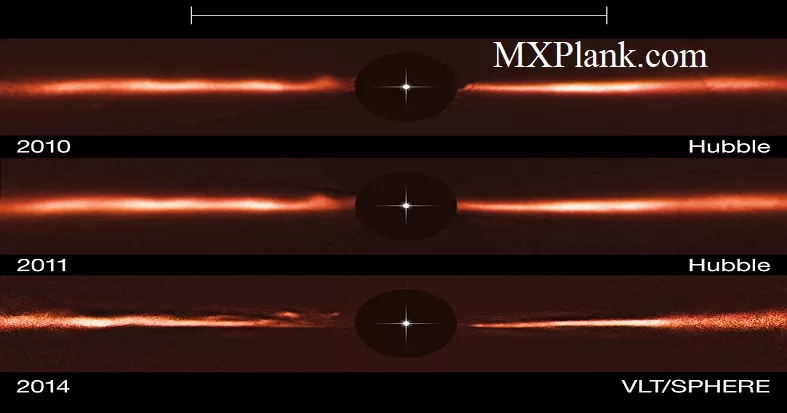Look at the bright star in the middle of this image. Achoo! It has just sneezed. This sight will only last for a few thousand years — a blink of an eye in the young star's life.
If you could carry on watching for a few years you would realise it's not just one sneeze, but a sneezing fit. This young star is firing off salvos of super-hot, super-fast gas — Achoo! Achoo! — before it finally exhausts itself. These bursts of gas have shaped the turbulent surroundings, creating structures known as Herbig-Haro objects.
These objects are formed from the star's energetic 'sneezes'. These salvos can contain as much mass as our home planet, and cannon into nearby clouds of gas at hundreds of kilometres per second. Shock waves form, such as the U-shape below this star. Unlike most other astronomical phenomena, as the waves crash outwards, they can be seen moving across human timescales. Soon, this star will stop sneezing, and grow up to be a star like the Sun.
This region is actually home to several interesting objects. The star at the centre of the frame is a variable star named V633 Cassiopeiae, with Herbig-Haro objects HH 161 and HH 164 forming parts of the horseshoe-shaped loop emanating from it. The slightly shrouded star just to the left is known as V376 Cassiopeiae, another variable star that has succumbed to its neighbour's infectious sneezing fits; this star is also sneezing, creating yet another Herbig-Haro object — HH 162. Both stars are very young and are still surrounded by dusty material left over from their formation, which spans the gap between the two

Herbig-Haro Object
Observations of protostars show that while material is falling onto the central object and accretion disk as expected, other material is being expelled from the system in both directions and perpendicular to the plane of the disk in what is known as a bipolar outflow. If the material in this bipolar outflow is travelling at very high velocities, typically hundreds of kilometres per second, it is commonly called a jet.
Herbig-Haro objects are bright knots of emission located wherever this high-velocity material interacts with its surroundings to produce hot, ionised gas. In addition, if the ejection velocities in the bipolar outflow change over time, faster moving material can overtake slower material ejected at an earlier time resulting in Herbig-Haro objects located along the direction of the outflow. Generally however, the brightest Herbig-Haro objects are found at the ends of the jet, where the material ploughs directly into the surrounding molecular cloud. Created in a dynamic fashion, they have been shown to evolve over timescales of only a few years, with existing knots becoming brighter or fainter or disappearing completely, and new knots forming where previously nothing was detected.
Typical Herbig-Haro objects have temperatures of around 10,000 Kelvin, densities from a few thousand to a few hundred thousand particles/cm3 and can contain up to 20 Earth masses of material. Once very rare, over 600 have been found to date, all in regions of star formation and usually associated with Bok globules
Herbig-Haro objects are small patches of nebulosity associated with newly-born stars, and are formed when gas ejected by young stars collides with clouds of gas and dust nearby at speeds of several hundred kilometres per second. Herbig-Haro objects are ubiquitous in star-forming regions, and several are often seen around a single star, aligned along its rotational axis.
HH objects are transient phenomena, lasting only a few thousand years at most. They can evolve visibly over quite short timescales as they move rapidly away from their parent star into the gas clouds in interstellar space (the interstellar medium or ISM). Hubble Space Telescope observations reveal complex evolution of HH objects over a few years, as parts of them fade while others brighten as they collide with clumpy material in the interstellar medium.
The objects were first observed in the late 19th century by Sherburne Wesley Burnham, but were not recognised as being a distinct type of emission nebula until the 1940s. The first astronomers to study them in detail were George Herbig and Guillermo Haro, after whom they have been named. Herbig and Haro were working independently on studies of star formation when they first analysed Herbig-Haro objects, and recognised that they were a by-product of the star formation process
Discovery and history of observations
The first Herbig-Haro object was observed in the late 19th century by Burnham, when he looked at the star T Tauri with the 36-inch refracting telescope at Lick Observatory and noted a small patch of nebulosity nearby. However, it was catalogued merely as an emission nebula, later becoming known as Burnham's Nebula, and was not recognised as a distinct class of object. However, T Tauri was found to be a very young and variable star, and is the prototype of the class of similar objects known as T Tauri stars which have yet to reach a state of equilibrium between gravitational collapse and energy generation through nuclear fusion at their centres.

Schematic diagram of how HH objects arise
Fifty years after Burnham's discovery, several similar nebulae were discovered which were so small as to be almost star-like in appearance. Both Haro and Herbig made independent observations of several of these objects during the 1940s. Herbig also looked at Burnham's Nebula and found that it displayed an unusual electromagnetic spectrum, with prominent emission lines of hydrogen, sulphur and oxygen. Haro found that all the objects of this type were invisible in infrared light.
Following their independent discoveries, Herbig and Haro met at an astronomy conference in Tucson, Arizona. Herbig had initially paid little attention to the objects he had discovered, being primarily concerned with the nearby stars, but on hearing Haro's findings he carried out more detailed studies of them. The Soviet astronomer Viktor Ambartsumian gave the objects their name, and based on their occurrence near young stars (a few hundred thousand years old), suggested that they might represent an early stage in the formation of T Tauri stars.
Studies showed that HH objects were highly ionised, and early theorists speculated that they might contain low-luminosity hot stars. However, the absence of infrared radiation from the nebulae meant there could not be stars within them, as these would have emitted abundant infrared light. Later studies suggested that the nebulae might contain protostars, but eventually HH objects came to be understood as material ejected by nearby young stars, and colliding at supersonic speeds with the interstellar medium (ISM), with the resulting shock waves generating visible light .
In the early 1980s, observations revealed for the first time the jet-like nature of most HH objects. This led to the understanding that the material ejected to form HH objects is highly collimated (concentrated into narrow jets). Stars are often surrounded by accretion disks in their first few hundred thousand years of existence, which form as gas falls onto them, and the rapid rotation of the inner parts of these disks leads to the emission of narrow jets of partially ionized plasma perpendicular to the disk, known as polar jets. When these jets collide with the interstellar medium, they give rise to the small patches of bright emission which comprise HH objects .

Herbig-Haro object HH47, imaged by the Hubble Space Telescope. The scale bar represents 1000 Astronomical Units, equivalent to about 20 times the size of our solar system, or 1000 times the distance from the Earth to the Sun
Physical characteristics
Emission from HH objects is caused by shock waves when they collide with the interstellar medium, but their motions are complicated. Spectroscopic observations of their doppler shifts indicate velocities of several hundred kilometres per second, but the emission lines in the spectra of HH objects are too weak to have been formed in such high speed collisions. This probably means that some of the material they are colliding with is also moving outwards, although at a slower speed .

HH objects HH1 and HH2 lie about a light year apart, symmetrically opposite a young star which is ejecting material along its polar axis
The total mass being ejected to form typical HH objects is estimated to be of the order of 1-20 Earth-masses, a very small amount of material compared to the mass of the stars themselves . The temperatures observed in HH objects are typically about 8000-12,000 K, similar to those found in other ionized nebulae such as H II regions and planetary nebulae. They tend to be quite dense, with densities ranging from a few thousand to a few tens of thousands of particles per cm3, compared to generally less than 1000/cm3 in H II regions and planetary nebulae . HH objects consist mostly of hydrogen and helium, which account for about 75% and 25% respectively of their mass. Less that 1% of the mass of HH objects is made up of heavier chemical elements, and the abundances of these are generally similar to those measured in nearby young stars .
Near to the source star, about 20-30% of the gas in HH objects is ionised, but this proportion decreases at increasing distances. This implies that the material is ionised in the polar jet, and recombines as it moves away from the star, rather than being ionised by later collisions. Shocking at the end of the jet can re-ionise some material, however, giving rise to bright "caps" at the ends of the jets.
Distribution Of HH Objects
Over 400 individual HH objects or groups are now known. They are ubiquitous in star-forming H II regions, and are often found in large groups. They are typically observed near Bok globules ( dark nebulae which contain very young stars) and often emanate from them. Frequently, several HH objects are seen near a single energy source, forming a string of objects along the line of the polar axis of the parent star.
The number of known HH objects has increased rapidly over the last few years, but is still thought to be a very small proportion of the total number existing in our galaxy. Estimates suggest that up to 150,000 exist , the vast majority of which are too far away to be resolved with current technological capabilities. Most HH objects lie within 0.5 parsecs of their parent star, with very few found more than 1 pc away. However, some are seen several parsecs away, perhaps implying that the interstellar medium is not very dense in their vicinity, allowing them to travel further from their source before dispersing
Proper motions and variability
Spectroscopic observations of HH objects show that they are moving away from the source stars at speeds of 100 to 1000 km/s. In recent years, the high optical resolution of Hubble Space Telescope observations has revealed the proper motion of many HH objects in observations spaced several years apart. These observations have also allowed estimates of the distances of some HH objects via the expansion parallax method.
As they move away from the parent star, HH objects evolve significantly, varying in brightness on timescales of a few years. Individual knots within an object may brighten and fade or disappear entirely, while new knots have been seen to appear. As well as changes caused by interactions with the ISM, interactions between jets moving at different speeds within HH objects also cause variations.
The eruption of jets from the parent stars occurs in pulses rather than as a steady stream. The pulses may produce jets of gas moving in the same direction but at different speeds, and interactions between different jets create so-called "working surfaces", where streams of gases collide and generate shock waves.

Images taken over five years reveal the motion of material in HH object HH47.
Infrared counterparts

Infrared image of molecular bow shocks associated with bipolar outflows in Orion. Credit: UKIRT/Joint Astronomy Centre
Herbig-Haro (HH) objects associated with very young stars or very massive protostars are often hidden from view at optical wavelengths by the cloud of gas and dust from which they form. This surrounding natal material can produce tens or even hundreds of magnitudes of extinction at optical wavelengths. Such deeply embedded objects can only be observed at infrared or radio wavelengths , usually in the light of hot molecular hydrogen or warm carbon monoxide emission.
In recent years, infrared images have revealed dozens of examples of "infrared HH objects". Most look like bow waves (similar to the waves at the head of a sailing ship), and so are usually referred to as molecular "bow shocks". Like HH objects, these supersonic shocks are driven by collimated jets from the two poles of a protostar. They sweep up or "entrain" the surrounding dense molecular gas to form a continuous flow of material, which is referred to as a Bipolar outflow. Infrared bow shocks travel at hundreds of kilometers per second, heating gas to hundreds or even thousands of degrees. Because they are associated with the youngest stars, where accretion is particularly strong, infrared bow shocks are usually associated with more powerful jets than their optical HH cousins.
The physics of infrared bow shocks can be understood in much the same way as that of HH objects, since these objects are essentially the same - it is only the conditions in the jet and surrounding cloud that are different, causing infrared emission from molecules rather than optical emission from atoms and ions .













